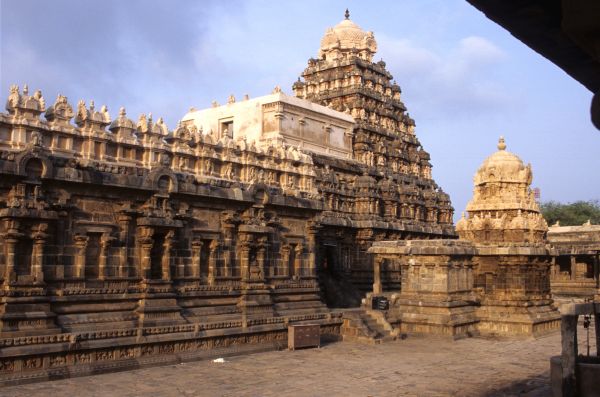|
DRAVIDIAN TEMPLE ARCHITECTURE
Airavateswarar Temple, Darasuram
Chola Period (10-11th Century)
Rajaraja Cholan II (1146-73)
"Darasuram is described as a sculptor's dream re-lived in
stone."


From
R.K.Das on Temples of TamilNad, 1964
Darasuram is a railway station on Madras-Tanjore line, in the
District of Tanjore. It is a very small town which has come to
eminence due to the famous Siva temple of Airavateswarar, which
abounds in archi tectural and rare sculptural specimens of
workmanship. The temple is fast deteriorating in its condition for
want of proper maintenance. Financial insufficiency and apathy of
the local people may be the reason. As I found it, the temple
precincts are full of wild growth of vegetation and many sculptural
works have been shifted to different places which is marring the
beauty of the temple.
The legend goes to show that Airavata, the white elephant of
Indra, worshipped Lord Siva in this temple; so did also the King of
Death, Yama. Tradition has it that the presiding deity
Airavateswarar cured Yama himself (the God of Death) who was
suffering under a Rishi's curse from a burning sensation all over
the body. Yama took bath in the sacred tank and got rid of the
burning sensation. Since then the tank is known as Yamateertham. It
gets its supply of fresh water from the river Kaveri and is 228 feet
in width. The pilgrims always make
a point to have a bath in the tank. In the recent past Raja Raja
Chola and Karikala Chola worshipped the Siva Lingam in this temple.
Volume II of the South Indian Temple Inscriptions deals with a
number of endowments of the Pandya Kings also (vide pages 556 to
562) On the temple walls these inscriptions are given, from which it
is seen that the temple was known in those days as Raja Rajeswararn
and Raja Rajapuram. Two such inscriptions are copied here.
Inscription No. 563 of the Book at page 557.No. 23 of 1908
on the inner Gopura of the temple, right of entrance. Record dated
in the 10th Year, Tai 11, of the reign of the Pandya King Maravarman
alias T ribhuvana Chakravartin Srivallabhadeva registering the
provision made for repairs and for celebrating festivals in the
temple of XXXI Ra (ja) ra (ja) isuram Udaiyanayanar, by the
residents of Uttattur-nadu, a sub-division of Kulottunga-valanadu.
Inscription No. 564 at page 558.
Record dated in the 31st Year, Makara, Ba. Dvitiya, Uttarashada
(probably a mistake for Uttaraphalguna) of the reign of the Chola
king Tribhuvana Ghakravartin Sri RAJARAJADEVA registering the grant
of land (Irandu Ma mukkani araikkani) 23/160 of a veli to meet the
expenses of worship, offerings, etc., to the God by a native of
Peruchchalipuram, a village in Kilar-kurram, a sub-division of
Pandyakulapati-valanadu.
As originally Airavata worshipped the Lingam, the Lingam is named
after him as Airavateswara. The Goddess in this temple is known as
Deva Nayaki. Whatever remains of the sculptural part of the temple
is on the inside wall of the outer prakaram, about a foot from the
floor level. 'The carvings contain different poses of gymnastic
feats we see in modern circus, shown by females keeping their head
at the centre and legs interwoven in such a skilful way as to form
the circumference of a circle. It may be a depiction of the
present-day gypsy tribe entertaining villagers with skilful
gymnastic shows and dancing poses. Such gypsies are still to be seen
visiting the interior villages of the country. Very many styles of
physical feats shown by both men and "men have been carved an stone.
All the dancing poses of
Bharatanatyam are carved an stone. There is a carving showing
the village womenfolk helping in delivery of another female, who has
put both her hands on the shoulders of the two ladies, who are
pressing their hands an the abdomen of the lady to help her deliver.
'These are very skilful and artistic works of superb style. This may
give a glimpse into the social conditions of the past. The stone
image of Ravana carrying Kailas is a fine specimen of workmanship.
At the very entrance to the temple two Dwarapalakas, Sankhanidhi
and Padmanidhi, are imposing figures, giving vivid anatomical
expressions of the exuberance of youth. In front of the temple,
there is a small mandapa, which can be reached by 3 steps in the
form of a ladder. The steps are made of stones, which give different
musical sounds when tapped All the seven swaras can be had at
different points. If proper care is not taken the village children
will spoil the stones soon.

The Front Mandapam
|